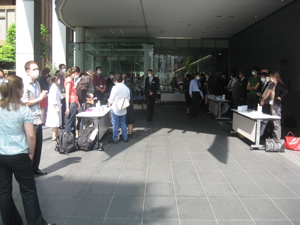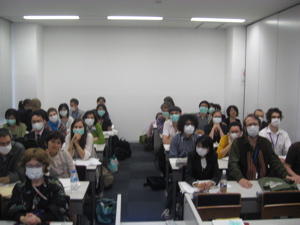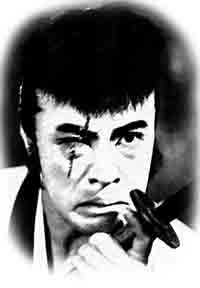One of the big chances for Japanese film studies was going to be the annual conference of the Society for Cinema and Media Studies in 2009. It was going to be the first time SCMS, the world's biggest film and media studies organization, was going to meet in Japan and it was going to be a great opportunity for those of us in Japanese film studies - as well as people in the film world in Japan - to present what they do to a world that has often been looking elsewhere. But unfortunately, due to reaction (some would say over-reaction) to the H1N1 virus by Japanese health officials, SCMS ended up canceling at the last minute (I'll talk more about this later). This deeply hurt all those who spend months organizing this thing. But the people rule! Lots of people said they wanted to present anyway, so with the help of Josai International University, which was originally the host of SCMS, we're doing an "alternative SCMS" tomorrow! Come one and come all - but be prepared for a health check at the door!
The Josai
International University Media Studies Department Media Workshop
Hosted by
Dean En Fukuyuki, Dean of Media Studies
Saturday,
May 23, 2009, from 10 am to 5 pm
Josai
Kioichō Campus
Schedule of Panels
Period 1: 10:00-11:50
1A:
Modern Femininity and Japanese Cinema
Chair: Chika Kinoshita (University
of Western Ontario)
Room 302
Miyoko Shimura (Waseda University)
“Japanese
Women's Films and Cosmetic Advertisement in the 1930s”
Ryoko Misono (University of Tokyo)
“Fallen
Women on the Edge of Empire: Shimizu Hiroshi’s Films on Yokohama and the Image
of Imperial Japan in the 1930s”
Sachiko Mizuno (UCLA)
“Reconfiguring
Modern Femininity for Empire: Professional Woman and Tokyo in WOMEN IN TOKYO
(1939)”
Chika Kinoshita (University of
Western Ontario)
“When
Abortion Was an Issue: The Post-1952 Japanese Films”
Yuka Kanno (University of
California, Irvine)
“Implicational
Spectatorship: Hara Setsuko and Queer Visual Formation”
1B:
Anxiety, Trauma and Violence in Recent Japanese Film
Chair: Tom Looser (NYU)
Room 301A
Mark Pendleton (The University of
Melbourne)
“Trauma
Cinema and the Legacy of Terror: Shiota Akihiko’s Canary and post-Aum Japanese
Film”
Oliver Dew (University of London)
“Melodrama
Wars: The Politics of the Wound and Contested Memories of the War in Recent
Japanese Films”
Kendall Heitzman (Yale University)
“The
Anxiety of Influence in Kurosawa Kiyoshi's Loft”
Elena del Rio (University of
Alberta)
“Form
and Performance of Death in the Cinema of Kitano Takeshi”
Rea Amit (Tokyo Geijutsu Daigaku)
“Japanese
Aesthetics, Violence, and the Cinema of Kitano”
1C:
GRAFICS and Early Cinema
Chair: André Gaudreault (Université de Montréal)
Room 301B
André Gaudreault (Université de Montréal) and Nicolas Dulac
(Université Paris III/Université de Montréal)
“The
Beginnings
of a New Cultural Series: The Moving Image”
Pierre Chemartin (Université de
Montréal)
"Alternation
and Simultaneity in Turn-of-the century Comics and Cinema. A Comparative Study of the Split-scene"
Louis Pelletier (Concordia University)
“Researching
Historical
Newspapers:
GRAFICS' Experience”
Marina Dahlquist (Stockholm University)
“’The Best-known Woman in the
World’: Pearl White and the Fate of the American Serial Film in Sweden”
Jan Olsson (Stockholm University)
“Love
Letters and Xenophobia: A Serial Queen at Hearst's New York Evening Journal”
1D: New Media Networks
Chair: Scott McFarlane (Concordia
University)
Room 401
Scott McFarlane (Concordia
University)
“Magic
Molecularity in Raul Ayala’s Melting Pots (2006)”
Wendy Chun (Brown University)
“Embodied
Networks: Cyworld and the South Korean Race / Nation”
Brian Goldfarb (University of
California, San Diego)
“Networks
for Redefining Disorder: Internet-based Public Health Intervention
Projects”
Satomi Saito (Bowling Green State
University)
“Crying
Out Love in the Center of the World: The Language of Bishojo Game”
1E: Animation and the Aesthetics of the Animated
Image
Chair: Markus Nornes (University of
Michigan)
Room 402
Livia Monnet (University of
Montreal)
“Perversion
and Modernity in Oshii Mamoru’s Ghost in the Shell 2: Innocence”
Eija Niskanen (University of Art and
Design, Helsinki)
“Riding
Through Air and Water – The Relationship Between Character, Background, Fantasy
and Realism in Hayao Miyazaki’s Films”
Muneaki Hatakeyama (Waseda University)
“Eisenstein’s Animal: A Reconsideration of the Eisensteinian Notion of
‘Movement’”
Tetsuya Miura (University of Tokyo)
“Robert Bresson and the Mise-en-scène of Automaton”
Takeshi Kadobayashi (University of Tokyo)
“Trajectory of the Cyborgian Smile: Man-machine Romances in Japanese
Visual Culture”
Respondent: Yoshiaki Sato (University of Tokyo)
1F:
Pacific Visions
Chair: Kirsten McAllister (Simon Fraser University)
Room 501
Cindy Mochizuki (Emily Carr University)
“Re-performing
Interviews from Slocan, Shizuoka, Fukuoka and on...”
Kirsten McAllister (Simon Fraser University)
“Temporal
Movements: From Historical Displacements to Transnational Flow”
Monika Kin Gagnon (Concordia University)
“Posthumous
Cinema: Unfinished Films and Theresa Cha's White Dust from Mongolia”
Roy Miki (Simon Fraser University)
“Rewriting
the Critical Affects: Reading 'Asian Canadian' in the Transnational Sites of
Kerri Sakamoto's One Hundred Million Hearts”
1G: Cinematic Cities and Monuments
Chair: Lucy Fischer (University of
Pittsburgh)
Room 502
Caroline Eades (University of
Maryland)
“A
New Cinematic Paris? Popular Views
of the Capital City by Cédric Klapisch, Abdellatif Kechiche and Jean-Pierre
Jeunet”
Merrill Schleier (University of the
Pacific)
“The
Griffith Observatory in Rebel Without a Cause (1955): Mystical Temple and
Spatiotemporal Structuring Device”
Homay King (Bryn Mawr College)
“Yamamoto's
Jacket: Wim Wenders' Notebook on Cities and Clothes”
Gary McDonogh (Bryn Mawr College)
“Transforming
the Banlieue: Jacques Tati’s Mon Oncle, Filmic Spaces and the Cultural
Geographies of Metropolitan Power”
1H: Russian Cinema in the Transnational Sphere
Chair: Yuna de Lannoy (Oxford
Brookes University/ Antwerp University)
Room 503
Olga Solivieva (independent
researcher)
“Colliding
Languages in Kurosawa’s Dersu Uzala”
Yuna de Lannoy (Oxford Brookes University/ Antwerp University)
“Soviet
‘Pollen’ in Japanese cinema: Legacies of Eisenstein’s Ivan the
Terrible in Three Films by Akira Kurosawa”
Jasmijn Van Gorp (University of
Antwerp)
“Cinema
and the Russian Federation: State-Sponsored Transnationalism to Reinforce the
Nation”
Ana Olenina (Harvard University)
“Indexicality
of the Virtual: The Russian Ark as an Affective Journey through the Digital Ruins of
Memory”
1I: Women's Representation, Women Filmmakers
Chair: KAWANO Yuka (Josai International University)
Room 504
ISHIJIMA Ayumi (Josai International University)
“The Representation and Discursive Construction of Women and Family: A
Comparative View of Japanese and Korean TV Dramas”
HAYASHI Chiaki (Josai International University)
“Young Women’s Agency: Heterosexuality in Japanese Contemporary Cinema”
MIYAZAKI Saeko (Josai International University)
“Contemporary Japanese Women’s Representation in the Post-Gender Era”
SHIBASAKI Sayuri (Josai International University)
“Race in Contemporary American Films: The Politics of ‘Passing’”
Period 2: 1:10-3:00
2A: Sex and Politics
Chair: Anne McKnight (University of Southern California)
Room 302
Maureen Turim (University of Florida)
“Desire as Political Allegory:
Japanese Film in the Sixties and Chinese Film in the Eighties”
Hoang Tan Nguyen (Bryn Mawr College)
“Bottom
Dwelling: Racial Shame and Sexual Politics”
Anne McKnight (University of Southern California)
“Home Alone: The Pink Film and the Gendering of
Everyday Life, 1971–1979”
Michael Arnold (University of Michigan)
“On
Location: Tsuda Ichiro, Pink Photography, and the Possibilities of
Representation”
Kimberly (Kim) Icreverzi (University of California, Irvine)
“The
Sensation of Affect: Genre and Tactics of Spectatorship”
2B:
International Film Festivals and the Framing of [Transnational] East Asian
Cinemas and Auteurs
Chair: Julian Stringer (University
of Nottingham)
Room 301A
Julian Stringer (University of Nottingham)
“Global
Auteurs and the International Film Festival Economy”
Shujen Wang (Emerson College)
“National
Cinema, International Film Festivals/Sales, and the Location of Tsai Ming-liang
Films”
Chris Fujiwara (independent scholar)
“Japanese Films in International Festivals”
Cindy Wong (College of Staten Island, City University of New York)
“Beyond Electric Shadows: The Hong Kong International Film Festival and
the Globalization of Chinese Language Cinemas"
Ann Yamamoto (University of Tokyo)
“Film
Festivals and the Regeneration of Local (Place-based) Culture through Globally
Networked Cinema Culture”
Respondent: Liz Czach (University of
Alberta)
2C: Film Aesthetics and Theory
Chair: Angela Della Vacche (Georgia
Institute of Technology)
Room 301B
J. Ronald Green (Ohio State
University)
“Narrative
and the Film Loop: Hubbard and Birchler”
Amber Bowyer (University of Southern
California)
“Ghost
Space: The Postmodern Construction of Space, Time and Authorship”
Angela Della Vacche (Georgia
Institute of Technology Paper)
“Alberti,
Kepler, Bazin and Children in Film”
Serazer Pekerman (University of St Andrews)
“’Memory-Space’
as the Smooth Battlefield of Deleuze and Guattarian War Machine”
Shota Ogawa (University of Rochester)
“Curtain
Call: Contesting Nostalgia at the End of Cinema, at the Edge of Honshu”
2D: Asian Cinema
Chair: Leo C. Chen (Seikei
University)
Room 401
Fan Yang (George Mason University)
“Second-Life
‘China’: i.MIRROR, Virtual Documentary and National Image-making in
Globalization”
Li Zeng (Illinois State University)
“The
Chinese Horror and the Return of the Historical Trauma: The Lonely Ghost in the
Dark Mansion (1989)”
Nikki J. Y. Lee (Yonsei University)
“Who
Says Revenge?: Popular Auteur-director Park Chan-wook and Tartan Asian Extreme”
Nicholas de Villiers (University of North Florida)
“Anno’s
Camera Eye: Sexuality, Youth, and Inoculation”
Nathaniel Heneghan (University
of Southern California)
“Takusan
no Takeshi: Conceptualizing Celebrity and Identity in Kitano’s Takeshis’”
2E: Transnational Crossings: Remakes, Reception
and Production
Chair and commentator: Stephanie
DeBoer (Indiana University)
Room 402
Jun Okada (State University of New
York, Geneseo)
“The
Ring:
Statelessness and Horror”
Yiman Wang (University of
California, Santa Cruz)
“Made
in China, Remade in US -- From Chinese Cinema to “Chinese Elements”, or What’s
Happened to Border Politics”
Lars Kristensen (University of St
Andrews)
“Nomad (2005) and Mongol (2007) in Epic
Transnational Straightjackets”
Hye Seung Chung (University of
Hawai'i at Manoa)
“Hallyu
Envy and Reverse Mimicry in Contemporary U.S. Pop Culture”
Phil Rosen (Brown University)
“Notes
on Art Cinema and the Emergence of Sub-Saharan Film”
2F:
The Importance of Sogo Ishii
Chair: Alexander Zahlten (Johannes Gutenberg University
Mainz)
Room 501
Alexander Zahlten (Johannes Gutenberg University Mainz)
“Free-floating
Intensity, Attraction, and Failure: Sogo Ishii at the Shifting Center of the
Film Industry of Japan”
Peter Rist (Concordia University)
“Sogo
Ishii’s Shuffle and the Evolution of the Chase Motif in World Cinema”
Randolph Jordan (Concordia University)
“In
Search of the Centre: Urban Soundscapes in the Cinema of Sogo Ishii”
Tom Mes (midnighteye.com)
“Key
Factor: Music in the Life and Work of Sogo Ishii”
2G: Experimental and Alternative Cinema in Japan
Chair: Mika Ko (University of
Sheffield)
Room 502
Ayami Ushida (Nihon University)
“The
Mysterious Scene between the Cinematic Image and the Original Novel”
Scott Nygren (University of Florida)
“Yoshida’s
Political Purgatory”
Deborah Shamoon (University of Notre
Dame)
“Casshern's Fictional Landscapes”
Steve Ridgely (University of
Wisconsin, Madison)
“Terayama
Shuji and Post-New Wave Experimental Cinema”
Miryam Sas (University of
California, Berkeley)
“Experimental-Documentary
Cinema Movements in 1960s Japan”
2H: Sonic Space
Chair: Erik Hedling (Lund
University)
Room 503
Alanna Thain (McGill University)
“Interior
Sonologues: Distributed Bodies and Cinematic Headphones”
Erik Hedling (Lund University)
“Music,
Lust and Modernity: Jazz in the Early Films of Ingmar Bergman”
Orlene Denice McMahon (University of
Cambridge)
“'La
Nouvelle Vague: A Musical Revolution?”
Jennifer Steetskamp (University of Amsterdam)
“Mapping,
Mobility, Augmentation: Installation Art and Media Histories”
2I:
American Cinema
Chair: Linda Ruth Williams (University of Southampton)
Room 504
Julia Leyda (Sophia University)
“’Fade
Away Never’: Spaces of Cultural Memory in Velvet Goldmine”
Arden Stern (University of California, Irvine)
“The
Naked Kiss:
Typography and the Veil”
Dale Hudson (Amherst College)
“Post-Westerns:
Vampires, Resident Aliens, and Other Immigrants”
Ashley White-Stern (University of California, Berkeley)
“Creative
Salvage: Class, Mobility and Circulation in Charles Burnett's Killer of
Sheep”
Minhwa Ahn (Cornell University)
“The
Question Melodrama Reconsidered: Limitations and Possibilities of the Woman’s
Genre”
Period 3: 3:10-5:00
3A: TV and Video around the World
Chair and commentator: Amy Villarejo
(Cornell University)
Room 302
Lynne Joyrich (Brown University)
“The
Magic of Television: Thinking Through Magical Realism in Recent U.S. TV”
Eirik Frisvold Hanssen (Norwegian
University of Science and Technology)
“Welcome
to the Nordvisision": Nordic Unity and Diversity as Televisual
Representation”
Karen Vered (Flinders University)
“Early
Australian TV Variety: A Heterogeneous Aesthetic in a Non-Networked Industry”
Azadeh Saljooghi (University of
Utah)
“Mobilizing
the Ethical Collective: New Practices in Palestinian and Israeli Documentaries
and Digital Media”
Sofia Bull (Stockholm University)
“'I'm
a Doctor, Mulder': Criminal Bodies in Contemporary Television Crime Dramas”
3B: Lust,
Caution
Chair: Gina Marchetti (University of Hong Kong)
Room 301A
Gina Marchetti (University of Hong Kong)
“Lust,
Caution:
China, Japan, and the KMT on Screen--Present and Past”
Patrick Boyle (University of California Irvine)
“Corporeal Acts, Fleshly Desire, and Ideological Restraints: Performance and Colonial Discourse in
Ang Lee's Lust, Caution”
Giorgio Biancorosso (University of Hong Kong)
"Lust
in Lust, Caution"
Katrien Jacobs (City University of
Hong Kong)
"The
Hong Kong response to Boudoir Realism: From Erotic Masterpieces to D.I.Y. Porn"
Maureen Sabine (University of Hong
Kong)
“The
Dark Heart of the Family Romance in Ang Lee's Lust, Caution (2007)”
3C:
Talking about Cinema: Japanese Film Theory and Japanese Benshi
Chair: Aaron Gerow (Yale University)
Room 301B
Naoki Yamamoto (Yale University)
“Overcome
by Reality: A Critical Approach to Realist Film Theories in Prewar Japan”
Ryan Cook (Yale University)
“Strange
Bedfellows: Oshima Nagisa, Hasumi Shugehiko and Japanese Film Theory”
Kyoko Omori (Hamilton College)
“The
Benshi as a Modernist: Tokugawa Musei and Psychological Films of the Early
Twentieth Century”
William Gardner (Swarthmore College)
“Sawato
Midori and the Contemporary Performing Art of Katsudo Benshi [Silent Film
Narrators]”
3D: Spaces of Modernity in Japanese Cinema
Chair: Ayako Saito (Meiji Gakuin
University)
Room 401
Alastair Phillips (University of
Warwick)
“Fractured
Landscapes: Space, Location and History in Uchida Tomu’s A Fugitive from the
Past
(1965)”
Alexander Jacoby (University of
Warwick)
“Yoshimura's
Kyoto: Space and Femininity in the Postwar City”
Woojeong Joo (Nagoya University)
“'Digesting
Modernity: Eating and Drinking Out Spaces of Ozu'”
Mark Roberts (University of
California, Berkeley)
“High-growth
Satire: Masumura Yasuzô in the Showa 30s”
Michael Raine (University of
Chicago)
“Masumura
Yasuzo and ‘Film Study’ in Japan”
3E: Transversing Japanese Cinema: Between the
Colonial and the Global
Chair:
Mayumo Inoue (University of the Ryukyus and University of Southern California)
Room 402
Mayumo
Inoue (University of the Ryukyus and University of Southern California)
“Hiroshima
beyond the aesthetics of failure: History, Materialism, and the City in Suwa
Nobuhiro's H Story”
Yasuko Ikeuchi (Ritsumeikan
University)
“Her Narrative and Her Body: Two Films by Kum Soni”
Bryan Hartzheim (UCLA)
“An
Asian Doll in French Clothes: Assimilation and Reception in the Films of
Tsuruko Aoki”
Kukhee Choo (University of Tokyo)
“Playing
the Global Game: Tokyo, the Anime Industry, and Nation State in Tekkon
Kinkreet
[2006]”
Chris Robinson (University
of Kansas)
“The ‘Exotic,’ the Universal,
and the Art-House Gross: East-West Relations and Marketing Japanese Film to
Foreign Audiences, 1951–1957”
3F: European Film
Chair: Janelle Blankenship
(University of Western Ontario)
Room 501
Tobias Nagl (University of Western Ontario)
“Ethnography,
Performance and Hybridity in the Weimar ‘Racial Film’”
Janelle Blankenship (University of
Western Ontario)
“The
Nature of Film: Nosferatu, Time Lapse and Weimar Popular Science Film
[1922–1928]”
Courtney White (University of
Southern California)
“Towards
an Abstract Modernist Painting in Cinema: Leopold Survage, Piet Mondrian, and
Oskar Fischinger”
Aya Ogawara (Seijo University)
“Going
between the Actual and the Virtual: Jacques Rivette's L'Amour par terre”
Jie Li (Harvard University)
“‘Just
Images’ of the Chinese Cultural Revolution: Antonioni’s Chung Kuo and Ivens/Loridan’s How
Yukong Moved the Mountain”
3G: Human Trafficking and the Body
Chair: Aga Skrodzka-Bates (Clemson
University)
Room 502
Aga Skrodzka-Bates (Clemson
University)
“Eastern European Woman as a Sex
Commodity: Slave Suicide in Cinematic Representation”
Hunter Vaughan (Washington
University in St. Louis)
“Sex Slaves in a Free Market:
Trafficking the Female Body and its Image in Two Films by Lukas Moodysson”
Kette Thomas (Michigan Technological
University)
“The Exacting Wound: Using Absence
as a Tool in Representations of Human Trafficking in They Call Me Dog and Lilya 4 Ever”
Maryn Wilkinson (University of Amsterdam)
“Wonder
Girls: The Close-up and the Image of the Teen Girl Body in Contemporary
American Cinema”
3H:
Remapping Cinematic Spaces
Chair: Tami Williams (University of Wisconsin-Milwaukee)
Room 503
Diane Wei Lewis (University of
Chicago)
“‘Kyoto, Hollywood of Japan’: Imaginary Geographies of the Japanese Film
Industry after the Great Kanto Earthquake of 1923”
Laura Horak (University of California-Berkeley)
"Cross-Gender Casting in Silent Cinema”
Christopher Natzén (Stockholm University)
“‘Have you heard it yet?’ - The Sound/Musicness of the Ads for the First
Sound Films in Sweden”
Brigitta Wagner (Indiana University)
“Retrospectives
and the Revival of Place”
Joshua Yumibe (Oakland University)
“Color Spaces and National Styles, from France to the U.S.”





